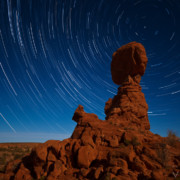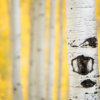How to choose Shutter Speed & Aperture for Nature Photography
Learning to use the three components of the exposure triangle (aperture, shutter speed, and ISO) to get a proper exposure is often one of the first things we master as new nature photographers. We must carefully balance all three to allow just the right amount of light into the camera so that the photograph is not too dark and not too light… but just right. However, getting the exposure correct is just one result of your choice of shutter speed and aperture. Both shutter speed and aperture have profound effects on your nature photography beyond just the exposure. Using them to pursue creative photography, with intention, will set your photographs apart from just snapshots.
Shutter Speed
Shutter speed is the amount of time the shutter is open to allow light to hit the sensor. Beyond controlling the amount of light, the shutter speed also has a profound effect on the perceived motion in your photos. A slow shutter speed is open for a longer time, allowing anything within the frame that is moving to blur. Conversely, a very short shutter speed freezes the motion of even a quickly moving subject. The creative choice of shutter speed in nature photography depends on whether you want to show motion with some degree of blur or whether you want the moving subject to be sharp and still in the frame. Thus, the choice of shutter speed when there is movement is a creative decision.
The following photo from the Smoky Mountains demonstrates this perfectly. I chose a rather slow shutter speed to allow the water flowing over the rock to blur a bit, thus enhancing the sense of motion in the image. Had I chosen a fast shutter speed, the water would have appeared frozen and would have had no feeling of movement. In a nature photos like this, I choose the shutter speed first, then balance the aperture and ISO to get a proper exposure.
In contrast, the following image of a loon during a preening wing flap was captured at a shutter speed of 1/1600 of a second. I had observed the loons over several days and could anticipate when they would rise out of the water and spin their heads around. I wanted to capture the water droplets flying off of their feathers. After a few missed shots with slower shutter speeds, I determined that I needed 1/1600 to freeze the water droplets. I balanced the aperture and ISO to get a good exposure as always. Because of the shutter speed I chose, the resulting photograph tells exactly the story that I wanted to tell.
These two nature photography examples demonstrate a critical concept about using shutter speed creatively in your work. You must first determine what you want to say with your image and then decide what shutter speed is required to tell that story. You still must be mindful of balancing your shutter speed with aperture and ISO for proper exposure.
Aperture
Just as shutter speed has a dual personality controlling exposure and perceived motion, aperture also has two sides to its coin. We know that aperture is the size of the opening in the lens that allows light to enter and hit the sensor. Obviously, a larger opening (smaller f-stop number) lets in more light.
But, in addition to having an effect on the exposure, the choice of aperture has a profound effect on the depth of field and how much of your image is in focus. A tiny aperture (larger f=stop number like f16) produces a large depth of field; you can have everything in focus from fairly close to your camera all the way to infinity. In contrast, a large aperture (small number like f2.8) results in a shallow depth of field. Depending on where you focus, a large part of your image may be out of focus.
So, depending on the story you want to tell, the choice of aperture is critical for nature photography. In fact, in my work, my decision about aperture is usually the first choice I make when determining a proper exposure.
When I am taking wide angle nature photos, I usually want everything to be in focus. This is particularly true when I have a strong foreground element. It is important that the foreground element be critically sharp and the distant background be acceptably sharp. I achieve this by using a wide-angle lens, a relatively small aperture, and focus just past the foreground element. I choose my aperture first, then balance shutter speed and ISO for exposure.
The following image from the Oregon Coast is a good example of this. I needed the foreground rock to be in focus as well as the distant sea stacks. Choosing an aperture of f14 gave me the depth of field that I needed and also allowed me to use a slightly slower shutter speed which helped to smooth out the reflection on the sand.
There are times when you want to highlight a part of your nature photo and don’t necessarily want everything in focus. Because our eyes always go to the brightest and sharpest part of a photograph, you can use this fact to bring attention to your subject and reduce background distractions. You do this by selecting an aperture that allows only your subject to be in focus.
For wildlife photography, I often use an aperture of 2.8 or 4 to have the subject’s face in focus and the background totally out of focus. When I photograph hummingbirds, I want the background to be out of focus to place attention on the sharply focused bird. In addition to selecting an aperture that blurs the background (in this case f8), I also make sure that the background is far enough away from the subject so that it is quite blurry. I couldn’t use an aperture of f4 on a hummingbird because they move too erratically and I need that extra depth of field to ensure a sharp eye on the bird.
Putting It All Together
When selecting the camera exposure for nature photography, remember that shutter speed and aperture control a lot more than just the amount of light entering the camera. You must get a proper exposure to avoid blown highlights, of course. But beyond that, remember the secondary effects of shutter speed and aperture and use that information in a creative way to tell your own story with your photograph.
Once you understand the basics of the exposure triangle and can get a properly exposed nature photo, you are ready to move beyond just a “proper image.” You are ready to use your camera settings to “paint” an image that conveys your message clearly to your viewer.
So, the next time you are setting up a shot, remember to think creatively about your choice of shutter speed and aperture. They can add much needed creativity to your nature photography than just exposure!







 Jaclyn Tanemura
Jaclyn Tanemura





Very nicely explain aperture shutter speed
Thank you.
Kiran Bhatt
I’m so glad the article was helpful to you! Photography is more easily mastered when we break it down into easier-to-comprehend parts, so that was my goal in writing this.
I hope you enjoy all the great resources here on Visual Wilderness!
Sincerely
Jane